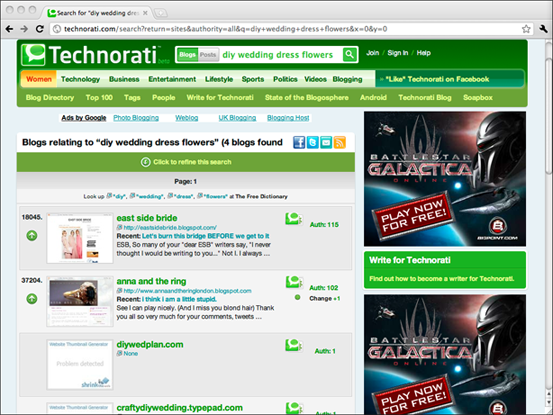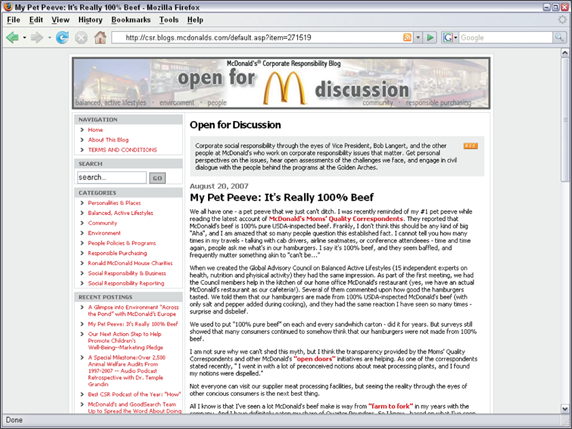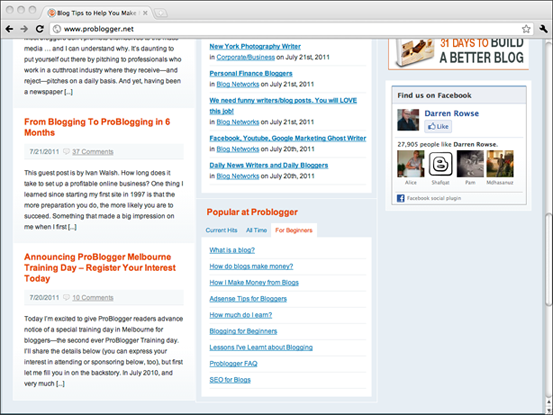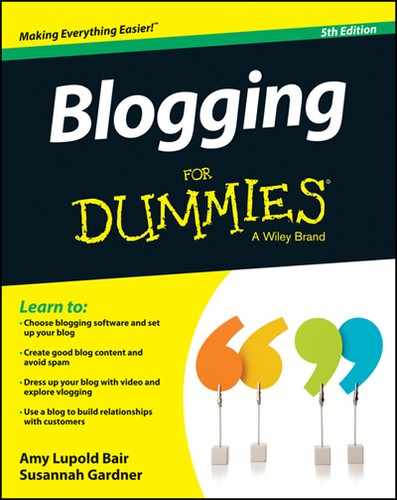Chapter 9
Creating Great Content
In This Chapter
![]() Discovering who your audience is
Discovering who your audience is
![]() Getting words onto your blog
Getting words onto your blog
![]() Adding value by including links
Adding value by including links
![]() Planning for blogging dry spells
Planning for blogging dry spells
Many elements work together to make a blog successful, from a well-designed layout to fancy technical widgets, but none of those elements can substitute for good content aimed at the right audience. In fact, if you write (or podcast or take photos) incredibly well and you're reaching readers who are engaged by your style and content, you can actually be successful without spending any time at all on your blog's appearance. Amazing content can even make your readers forgive an awkward interface or missing bells and whistles, such as RSS feeds or categories.
So, if you do nothing else to make your blog succeed, focus on producing great writing, photos, audio, or videos. Know what your audience wants and deliver it.
Most blogs include a written component, or are predominantly word based, so this chapter offers pointers on writing well for the web and understanding what your audience expects from your blog.
Knowing Your Audience
First things first: How well do you know your audience? Are you hitting the right notes to attract the readers you want in the quantity you want them?
You can get an idea about your audience by
- Using statistics software to track the number of visitors to your blog and what links those visitors click
- Noting the content that elicits the biggest and best response from your readers (or the response that you want, even if it isn’t the biggest)
- Looking at the blogs of others in your subject area to see what you can find out from their comment activity, search engine rankings, and other data
You might have to wait awhile for statistics and comments, but you can easily look at others’ blogs, even if you're still developing your own blog. I talk in detail about measuring site traffic and statistics in Chapter 19, so jump there if you want to find out more about the readers you already have.
Finding your competitors
To find your competitors, you must first define your own niche. Your niche consists of what you're blogging about, the topics you cover, and what words you use most frequently in your posts. You use these keywords to describe yourself, and visitors use them to find you when they conduct a search on Google, Yahoo!, Bing, or another search engine.
Use these descriptive words (plus the word blog) to locate blogs that have similar content to yours. You can also use one of the blog search engines, such as Technorati (www.technorati.com), Google Blogs search page (http://blogsearch.google.com), or Icerocket (www.icerocket.com). Figure 9-1 shows the results of a search on Technorati that used the terms diy, wedding, dress, and flowers. These results show posts from blogs that talk about these topics.

Figure 9-1: Use Technorati to find your competitors’ blogs.
Discovering the secrets of success
While you watch your competitors’ blogs, you have a chance to figure out what topics they blog about, of course, but also how they reach out to their audience.
While you visit these blogs, keep a journal of your impressions. Watch the following to investigate how these bloggers handle publishing and outreach:
- How frequently the blogger puts new posts on the blog: Frequency of blog posts is a big deal. Any blogger can tell you to post “frequently,” but almost none can tell you what that really means. I talk more about how often you should post in the section “Writing Well and Frequently,” later in this chapter, but you can explore this idea by noting how often your competitors choose to post to their blogs. Do they create new posts daily, or even multiple times a day? Or do they post a few times a week, or even once a week? When you become a reader of that blog, do you find yourself wanting more content or less?
- When the blogger publishes blog posts: Time of day can have a surprising impact on how readers receive a blog post. You need to reach your audience members when they’re likely to be sitting at their computers. If your audience consists of stockbrokers, time your posts so that new content becomes available just before business hours start on the East Coast, not during dinnertime on the West Coast. If you’re targeting teens, try to publish before or after school hours, not while they’re sitting in homeroom. (Theoretically, they are doing schoolwork at that point and not surfing the Internet!)
 Sure, your readers can visit your blog anytime and pick up content that you posted in the middle of the night, but you can impress them with a blog that always seems to have fresh content just when they want it.
Sure, your readers can visit your blog anytime and pick up content that you posted in the middle of the night, but you can impress them with a blog that always seems to have fresh content just when they want it. - The length of posts on the blog: You might be surprised to know that the ideal length of a blog post is a hotly debated topic among experienced bloggers. Some bloggers swear by the short-and-sweet recipe that guides most web writing: Blog posts should get to the point quickly and allow readers to get back to their busy days with the information that they need. Others find that longer posts — even essays — do the job, keeping readers on the site longer and providing more thoughtful commentary. The topic of your blog and your audience’s appetite and available time combine to dictate the natural length of your blog posts. Looking at your competitors’ blogs can tell you the number of words that they find optimal in a blog post, which you can use as a starting point for your blog.
- When the blogger links to outside websites: Linking to other blogs and websites is a great way to serve the reader. By pointing out other sources of information or even other blogs, you help them become more knowledgeable about your topic and keep them engaged with it. So, when do your competitors choose to link to other sites, and what sites do they link to? Are the links designed to entertain, educate, or inform? Are links included in the text of the post or broken out at the end? What makes you click a link yourself?
I talk a lot more about linking to other sites as a strategy for reaching your audience in the section “Linking to Serve the Reader,” later in this chapter.
- When the blogger addresses his or her audience directly: Many bloggers use a very personal writing style that directly acknowledges the reader, the way this book does. You might enjoy being addressed directly by a blogger because the conversation feels more personal. Or, depending on the topic of the blog, perhaps a more formal, almost academic approach is more appropriate. Either way, check out how your competition is handling this issue. When do they ask readers for input or feedback, and how do they phrase those requests? Do readers actually respond, and if so, to what kinds of approaches?
- Use of multimedia, such as photos, audio, and videos: Although most blogs consist of a whole lot of words, you can still throw in the occasional (or even frequent) picture or video. In fact, bloggers do it all the time to dress things up visually and keep readers interested. Take a look at how your competitors include multimedia in their blogs. Do they use photos to illustrate the ideas in the posts or just to attract the eye? What about animation or video? Do posts that have these extras get more comments or fewer? Do you like getting information in these other formats or do you find them distracting?
- Posts that get a lot of comments and posts that get very few: A blog that gets a lot of comments signals that the blogger is resonating with his or her audience — even if just to make audience members mad. A blog that has no or few comments probably just leaves people flat (or maybe isn’t even read). Not all bloggers get hundreds of comments every time they post. Some blog posts just get better responses than others, and part of what makes bloggers successful is being able to know what makes those posts really work so that they can repeat the success. Watch your competitors’ blogs to see when a post gets a big response and look at what kind of response it gets.
 Also, watch for the posts that don't get any responses. Try to figure out why those posts didn't work so that you don't make the same mistake!
Also, watch for the posts that don't get any responses. Try to figure out why those posts didn't work so that you don't make the same mistake! - The writing style of the blogger: Bloggers need to have good content, and for most bloggers, that comes down to having an accessible and readable writing style. For those blogs in your niche that attract participation and good press, what style does the blogger use? Personal? Professional? Humorous? What tone appeals to readers and makes them come back to the blog again and again? What approach do you find more readable and engaging?
Use these same points of analysis on your own blog. After you have your blog up and running for awhile, take a look at your content with the same critical eye that you use on your competitors. What are you doing right? What are you doing incorrectly?
You may find this exercise hard to do. I'm sure you think that everything on your blog is great; after all, no one sets out to write a bad blog post! Still, some of your posts are likely more popular with readers than others, and if you can figure out why certain posts work better than others, you can repeat that success again and again. In fact, developing a critical eye for your own content can really help you make your blog succeed: This medium doesn't hold still, and you need to adapt your style and content while your audience grows and changes. Consider conducting this kind of survey of your content a couple times a year to make sure that you stay on track and topical to the folks you want to attract, even if you're aiming for just your immediate family.
If you find it tough to view your own content through that kind of lens, but you have a friend or two who get what you are doing and can look at it critically, ask them to do a site review. Just remember, they are giving you opinions and advice, but it's your call whether you implement any of that!
Profiling your audience
When you finish your competitive analysis (which I explain how to do in the preceding section) and after you review your own content successes and failures, picture your audience in your mind's eye.
Create a clear vision of who's in your audience. If you don't have the audience you're targeting at this point, develop a picture of whom you want in your audience.
You don't actually have to draw a picture, though. You can create this profile in words that describe the characteristics of your ideal audience member. You can include anything that you want in this profile, from shoe size to personal hang-ups — any detail that helps you really know this person better and create content for this person on your blog.
Take Gizmodo, as shown in Figure 9-2. Gizmodo (www.gizmodo.com) is a techie blog featuring information on gadgets and other nifty technical devices. The blog's tagline is “Gizmodo, the gadget guide. So much in love with shiny new toys, it's unnatural.” Right away, you know that the audience for Gizmodo is more than just those interested in gadgets. Gizmodo readers adore gadgets, see them as playthings meant to entertain and amuse, and are perhaps unhealthily engaged by them (maybe at the expense of other hobbies and pursuits). And those audience members want their gadget news piping hot, fresh off the presses. Doesn't that tell you more about what kinds of posts will work best to attract and keep these kinds of readers?

Figure 9-2: Gizmodo focuses on the fanatical gadget enthusiast.
Some concepts and facts to explore for your audience profile include
- Age
- Gender
- The nature of their interest in your topic (for example, familial, personal, emotional, or professional)
- Geographic location and proximity to you or to the topic of your blog
- Lifestyle (for example, workaholic, homebody, retired, world traveler, and so on)
- Occupation
- Education level
- Marital status
- Interests and hobbies
- Income range
- Political leanings
When you have a reader profile in hand, you can be more targeted about what you choose to write about and how you address that audience.
Writing Well and Frequently
Two of the many ingredients for a successful blog are good and frequently updated content. But what does it really mean to provide good and frequent content?
Good content compels, satisfying the readers’ immediate interests but leaving them hungry for more. Think of a blog post as being like an appetizer: It should whet the appetite, pique the palette, and sustain the diner until the next course arrives. You don't want to give your readers “annual Thanksgiving dinner” — you want them to come back, come back soon, and come back often.
Blogging is quite a personal, conversational medium, and textual blogs have a strong feel of the author and his or her personality. The first blogs were actually online diaries, and even today, most bloggers choose to use words such as I or my in their blog posts, creating an intimate and open feel — even on corporate blogs. This first-person writing differs dramatically from most corporate communication, which at best refers to the company as our and at worst only refers to the company by its full and official name.
Take, for example, one of the McDonald's blogs, Open for Discussion, which was written by McDonald's Vice President Bob Langert. In a post on August 20, 2007, Bob wrote:
“We all have one — a pet peeve that we just can’t ditch. I was recently reminded of my #1 pet peeve while reading the latest account of McDonald’s Moms’ Quality Correspondents. They reported that McDonald’s beef is 100% pure USDA-inspected beef. Frankly, I don’t think this should be any kind of big ‘Aha’, and I am amazed that so many people question this established fact.”
Figure 9-3 shows this post.

Figure 9-3: Even vice presidents are informal on blogs, as McDonald's V.P. Bob Langert was on Open for Discussion.
Writing in the first person isn't as easy as it looks (or reads); after all, most people spend years training to write more formally, and commonly produce all kinds of documents in which first-person writing is emphatically not suitable: memos, reports, news stories, invoices, and so on. You may have trouble finding an authentic, genuine voice that really feels comfortable. My best advice is to just practice, practice, practice.
If you'd like your blog to have a casual tone, think of your blog posts as being like letters or e-mails. Speak directly and simply, as you would in a personal note or letter. Try not to overthink your words, but don't go right into stream of consciousness (fun to write, hard to read).
Linking to Serve the Reader
Links — you need ’em. You may worry that by providing a link to a news story or online article, you're sending your readers away from your site into the black hole of the Internet, never to return. Your readers might, in fact, click the link and go read the article. But they probably won't forget where they found the link.
On a blog, links are just as much a resource as any other information that you provide. In fact, many blogs actually consist of collections of links around a topic or theme, pulled together to inform or entertain the blog's readers.
Joey deVilla doesn't shy away from adding links to his blog posts on The Adventures of Accordion Guy in the 21st Century (www.joeydevilla.com), as shown in Figure 9-4.

Figure 9-4: Joey deVilla adds a lot of links to his blog posts, helping his readers get more information.
In a September 20, 2007, post about the Canadian dollar's parity with the U.S. dollar, he included links to bios of the U.S. president and Canadian prime minister in office during the last time the currencies were equal, and he provided links to pop culture references current at that time. Also, he collected a list of news stories that covered the event.
Speaking of dollars, links are the currency of the blogosphere. A lot of bloggers point their readers to blog posts that they find especially interesting, even going so far as to quote the other blogger. In the sidebars of their blogs, bloggers regularly build lists of links to blogs that they read. These lists are called blogrolls.
In general, bloggers are generous about linking to other blogs and websites because the favor is frequently returned. As the saying goes, “You have to spend a little to make a little.”
The Web Style Guide (www.webstyleguide.com) covers everything from good web design standards to graphics production, but you can probably benefit most from Chapter 9 of the guide, which covers links, titles, and common online styles.
Breaking Through a Blank Screen
At times, even outstanding bloggers hit dry spells and can't think of a word to write. You can safely anticipate a day sometime in the life span of your blog when you literally have nothing to say to your readers, no matter how much enthusiasm you have for your topic.
This phase will pass, but sometimes, you need a little help pushing back to a productive spot. Here are a few tips for making it through your dry spell:
- Stockpile a few evergreen posts. In newsrooms around the world, journalists regularly create evergreen stories (stories that can be printed or televised at any time and still be interesting). You can also put together a few evergreen blog posts that you can keep on hand for use on a day when your creative juices temporarily dry up. You can also use these kinds of posts for days when you’re sick or on vacation but still want to have something publish on your blog. A lot of blog software allows you to schedule a publication date for a blog post in the future, so you can even set these posts to go up automatically while you take a well-deserved break.
- Ask a friend to guest blog for a few days. Bring some new perspective to your blog when you have none left yourself by asking a friend, colleague, fellow blogger, or even critic to write some blog posts for you. Your readers might enjoy the change of style and tone (and if they don’t, you make them that much happier when you come back!). Be sure to return the favor when your guest blogger has a dry spell of his or her own.
- Recycle an oldie but goodie. When you can’t think of exciting new content, bring out a great post from your archives. New readers appreciate seeing something they missed, and old readers might find new information in a second read. Professional blogger Darren Rowse points his readers to a list of best-of posts on ProBlogger (
www.problogger.net). In fact, Darren pulls out the best posts of all time, for the month, for new readers, and just some of his favorites (see Figure 9-5).
Figure 9-5: Darren Rowse points people to favorite posts from the past.
- Post a photo. Rather than 1,000 words, put up a single photo. Take a picture of where you usually blog, show off your new laptop, or just take a walk in your neighborhood. You can dig out a photo of yourself as a kid or show that embarrassing haircut you had in the ’90s.
- Post about the books, movies, or television that you're consuming. Tell folks about the other media you’re enjoying. You can even hook up an Amazon Associates account and earn a little money from your recommendations. (You can find out how to set up this kind of account in Chapter 20.)
- Give out your favorite recipe. Dig out the cookbook and find your grandmother’s fudge recipe or your mom’s apple pie recipe and share it with your readers. Better yet, take a break from the computer and make the recipe yourself so that you can put up a photo with your post.
- Blog from a new location. Sometimes, breaking the routine can shake loose those recalcitrant brain cells. Try blogging from another room in your house, or head to the local Internet cafe or coffee shop.
- Record an audio podcast or video blog (vlog). If you can’t write, talk! You might be pleasantly surprised and make this a regular feature of your blog. Chapters 13 and 14 cover podcasting and vlogging extensively.
- Do an interview. Ask a friend, colleague, neighbor, child, parent, boss, or public figure whether you can interview him or her for your blog. Type up a few questions, e-mail them off, and when the answers arrive in your inbox, a little copying and pasting should do the trick.
- Take a quiz. Let your readers know what superhero you are or what color your personality is by playing with some of the fun quizzes and polls online. The Superhero Quiz is at
www.thesuperheroquiz.com(I’m Spider-Man), and you can find loads of others on blogthings (www.blogthings.com) and Quiz Meme (www.quizmeme.com). - Ask for suggestions from your readers. Appeal to your readers for help with finding new topics to post about. Also, look through your old posts and see whether you can expand on a post that worked well; check out comments and e-mails from readers, too!

 Your competitors might not be blogging in the most effective way. While you look at these blogs, decide whether your competitors are actually reaching their audiences successfully or whether they're falling short. For example, do their blog posts receive a lot of comments? Has their content been shared often on social media sites?
Your competitors might not be blogging in the most effective way. While you look at these blogs, decide whether your competitors are actually reaching their audiences successfully or whether they're falling short. For example, do their blog posts receive a lot of comments? Has their content been shared often on social media sites? Don't just say, “My ideal audience is anybody who is interested in [insert your blog topic here].” You already know that. Otherwise, this person wouldn't be on your blog in the first place. You want to capture all the details that make this person different, unique, and interesting.
Don't just say, “My ideal audience is anybody who is interested in [insert your blog topic here].” You already know that. Otherwise, this person wouldn't be on your blog in the first place. You want to capture all the details that make this person different, unique, and interesting.